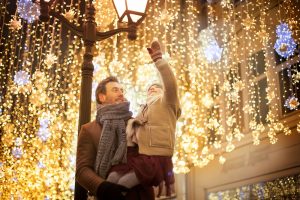It’s officially the holiday season, and you know what that means – twinkling lights abound, every way you look. These light shows certainly make for a pretty sight, but what do they mean for your eyes?
 This season, you’re likely to see red and green strings of lights lining houses, trees, and streets throughout your neighborhood. Of course, you can’t forget about white, blue, yellow, and the always-popular rainbow lights that make up so many residential and business decorations.
This season, you’re likely to see red and green strings of lights lining houses, trees, and streets throughout your neighborhood. Of course, you can’t forget about white, blue, yellow, and the always-popular rainbow lights that make up so many residential and business decorations.
All of these colors are part of the Visible Light Spectrum, which is just what it sounds like – the spectrum of light that humans can visibly see. Red has the longest wavelength, with orange, yellow, green, blue, and violet each having a shorter wavelength than the last. The color white, meanwhile, is a mixture of all the colors.
Most visible light isn’t inherently dangerous to the human eye, but of course you want to keep from staring too long or too intensely at these displays to avoid irritating your eyes unnecessarily. If you get in your car to tour a light show or to look at your neighborhood decorations, you can feel fairly comfortable doing so – just exercise good judgment in letting your eyes rest now and again.
If you find yourself experiencing more severe symptoms when looking at Christmas lights, it might be a sign of a deeper issue. For instance, if holiday lights are causing you to see starbursts, it could indicate that you either need vision corrective lenses or that you are experiencing the beginning signs of cataracts or glaucoma. In either case, reaching out to your family eye care provider to dig deeper into the symptoms is the wisest next step.
Another sign to look out for is frequent headaches after looking at bright lights. If you find yourself experiencing more headaches this season and you think it might be tied to holiday light displays, it may be a sign of poor vision. This is especially true if you’ve also noticed blurred vision of late. An annual eye exam can prevent these stressors, but if you haven’t attended one in a while, you’ll want to schedule an appointment with your eye care provider to ensure that your eyes remain in tip-top shape.
Speaking of blurred vision, holiday lights aren’t the only indicators of eye issues this season. Blurred vision can make itself known in a number of ways, including difficulty reading holiday cards or dessert recipes, so if you find yourself squinting or struggling to read words you’ve never had trouble with before, it might be a sign that new lenses are in your future.
Of course, 2020 has its own special challenges when it comes to the holidays. As more of us stay inside and distanced from family members, we’re all grateful for the advent of technology like Zoom, FaceTime, Skype, and other video messaging services that allow us to see and speak to our loved ones in real time, even when we’re many miles apart.
That being said, the use of computers, tablets, phones, smart TVs, and other platforms that support these game-changing services do pose a risk to our eyesight. But don’t despair or cancel your family Zoom meet-up just yet! The risk is manageable, but it will take some work on your end to ensure those eyes stay sharp.
The light that is produced by these screens is called blue light. If you recall from our earlier explanation of the Visible Light Spectrum, blue light is near the end of the line in terms of wavelength. This means that it carries a lot of energy at once.
Perhaps you’ve heard warnings that staring at your phone right before bed can lead to difficulty falling asleep. This is due to the amount of blue light phones produce, which can disrupt the sleep cycle by throwing off our circadian rhythm, which is the internal system that helps the mind and body sleep at night.
Blue light can do a lot more than just disrupt our sleep schedule. It is thought to be a culprit of Digital Eye Strain, also known as Computer Vision Syndrome. Blue light has also been tied to macular degeneration, a serious eye condition that damages the retina. Macular degeneration has a number of side effects, and at its most severe, it can cause blindness.
So what should you do to protect your eyesight? Thankfully, there are several solutions available! In the short-term, you can take advantage of what’s called the 20/20/20 method (an easy-to-remember name, given the year!), which entails taking the time, every 20 minutes, to look at least 20 feet away for 20 seconds. This is an easy way to give your eyes a break from the intense blue light of digital screens – you can even set a timer to remind yourself when it’s time to look away.
Another tactic you can use is purchasing a pair of blue light glasses, which you can find through your family optical or online. These glasses reduce the amount of blue light that actually reaches your eyes, thereby decreasing eye strain and its associated side effects. If you already wear glasses, you can purchase a pair to fit over them, and many brands now offer blue light-filtering lens coatings for their glasses, so the next time you’re in to update your prescription, be sure to ask about your options!
We hope you have a safe and healthy holiday season, and that these tips help you keep your eyes in the best shape possible as we enter the new year.









